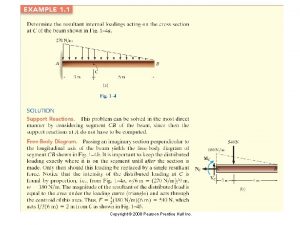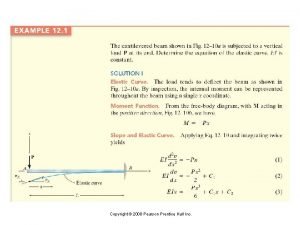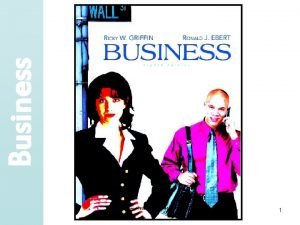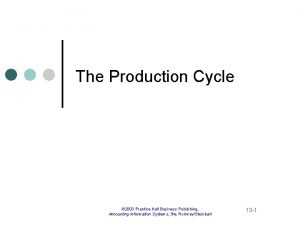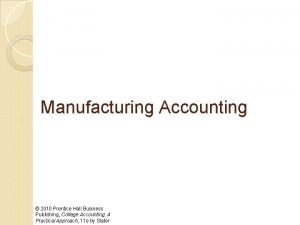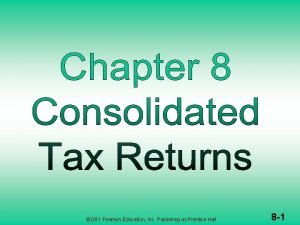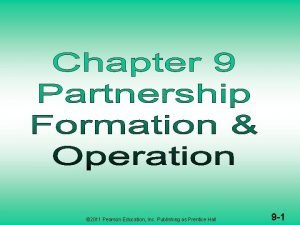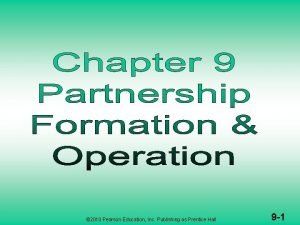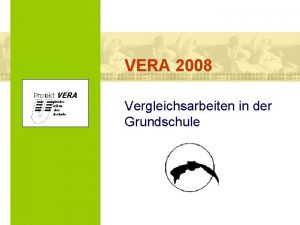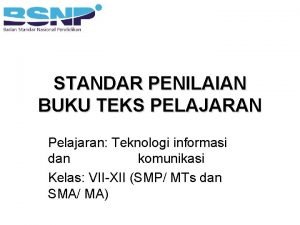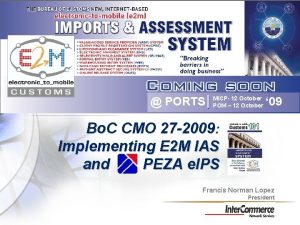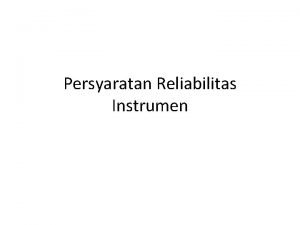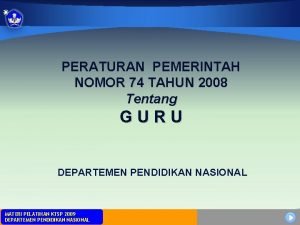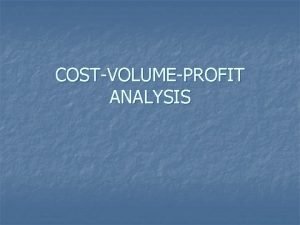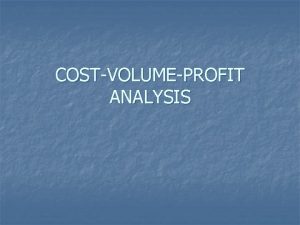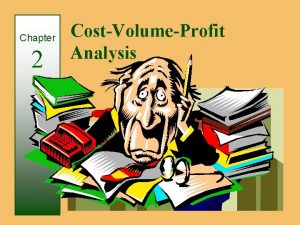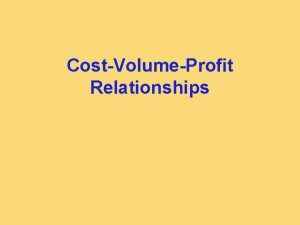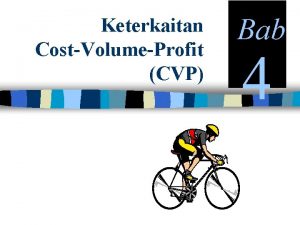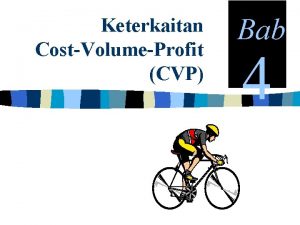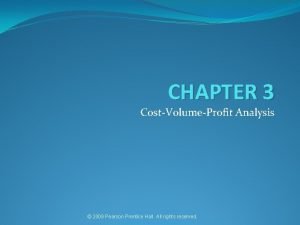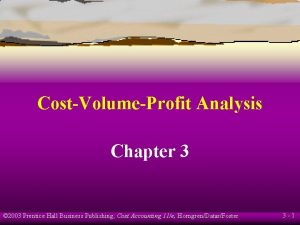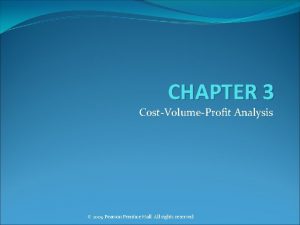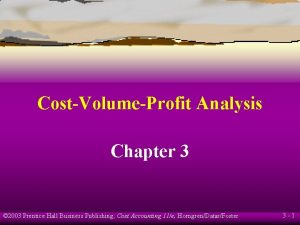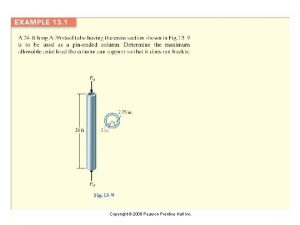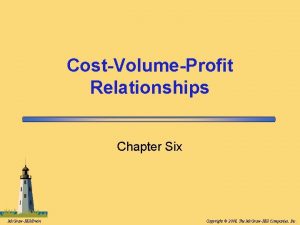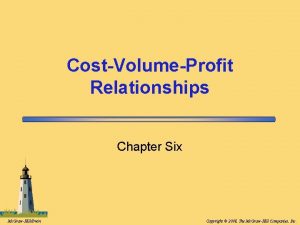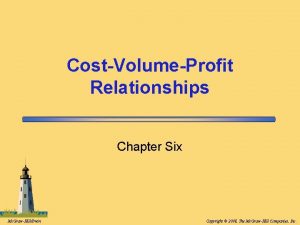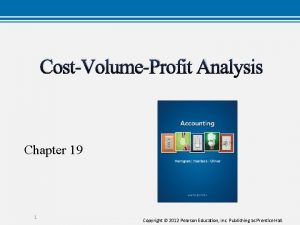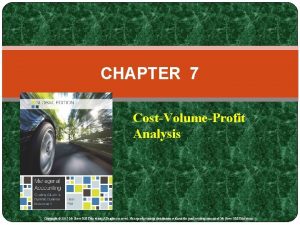CostVolumeProfit Analysis Chapter 7 1 Copyright 2008 Prentice


























































- Slides: 58

Cost-Volume-Profit Analysis Chapter 7 1 Copyright © 2008 Prentice Hall All rights reserved

Objective 1 Calculate the unit contribution margin and the contribution margin ratio 2 Copyright © 2008 Prentice Hall All rights reserved

Components of CVP Analysis • • • Sales price per unit Volume sold Variable costs per unit Fixed costs Operating income 3 Copyright © 2008 Prentice Hall All rights reserved

CVP Assumptions 1. Change in volume is only factor that affects costs 2. Managers can classify each cost as either variable or fixed • These costs are linear throughout relevant range 3. Revenues are linear throughout relevant range 4. Inventory levels will not change 5. The sales mix of products will not change 4 Copyright © 2008 Prentice Hall All rights reserved

Unit Contribution Margin Sales price per unit - Variable costs per unit Contribution margin per unit Example: Sales Price per Poster Less: Variable Cost per poster Contribution Margin per poster $35 (21) $14 5 Copyright © 2008 Prentice Hall All rights reserved

Contribution Margin Ratio Unit contribution margin Sales price per unit Example: Unit contribution margin $14 = 40% Sales price per unit $35 6 Copyright © 2008 Prentice Hall All rights reserved

Objective 2 Use CVP analysis to find breakeven points and target profit volumes 7 Copyright © 2008 Prentice Hall All rights reserved

Breakeven Point • Sales level at which operating income is zero • Sales above breakeven result in a profit • Sales below breakeven result in a loss 8 Copyright © 2008 Prentice Hall All rights reserved

Income Statement Approach Contribution Margin Income Statement Sales - Variable Costs Contribution Margin - Fixed Costs Operating Income 9 Copyright © 2008 Prentice Hall All rights reserved

Short-Cut Approach Using the Unit Contribution Margin Units sold = Fixed expenses + Operating income Contribution margin per unit 10 Copyright © 2008 Prentice Hall All rights reserved

Short-Cut Approach Using the Unit Contribution Margin Ratio Sales in $ = Fixed expenses + Operating income Contribution margin ratio 11 Copyright © 2008 Prentice Hall All rights reserved

E 7 -15 1. Contribution margin ratio = Contribution margin ÷ Sales = $187, 500 ÷ $312, 500 = 60% 12 Copyright © 2008 Prentice Hall All rights reserved

E 7 -15 1. Hint: Contribution margin income statements are produced by using the different volume levels and the calculated variable Statements expenses. Aussie Travel Contribution Margin Income Sales revenue $250, 000 $360, 000 Variable expenses (40%) 100, 000 144, 000 Contribution margin $? $? Fixed expenses 170, 000 Operating income (loss) $ (20, 000) $46, 000 13 Copyright © 2008 Prentice Hall All rights reserved

E 7 -15 2. Sales in $ = Fixed expenses + Operating income Contribution margin ratio Sales in $ = $170, 000 + $0 = $283, 333 60% 14 Copyright © 2008 Prentice Hall All rights reserved

E 7 -17 1. Contribution margin = Sales–Variable costs = $1. 70 - $0. 85 = $0. 85 Contribution margin ratio: Contribution margin per unit = $0. 85 = 50% Sales price per unit $1. 70 15 Copyright © 2008 Prentice Hall All rights reserved

E 7 -17 2. Breakeven sales in units: Fixed costs + Operating income ? ($85, 000 + $0) / ? = 100, 000 units 16 Copyright © 2008 Prentice Hall All rights reserved

E 7 -17 2. Breakeven sales in dollars: Fixed costs + Operating income Contribution margin ratio ($85, 000 + $0) / 50% = $170, 000 17 Copyright © 2008 Prentice Hall All rights reserved

E 7 -17 3. Sales in units: Fixed costs + Operating income Contribution margin per unit ($85, 000 + $25, 000) / $0. 85 = 129, 412 units 18 Copyright © 2008 Prentice Hall All rights reserved

Graphing the CVP Relationships Step 1: § Choose a sales volume § Plot point for total sales revenue § Draw sales revenue line from origin through the plotted point 19 Copyright © 2008 Prentice Hall All rights reserved

Preparing a CVP Chart • 20 Copyright © 2008 Prentice Hall All rights reserved

Preparing a CVP Chart Step 2: § Draw the fixed cost line 21 Copyright © 2008 Prentice Hall All rights reserved

Preparing a CVP Chart 22 Copyright © 2008 Prentice Hall All rights reserved

Preparing a CVP Chart Step 3: § Draw the total cost line Hint: What are the two factors that comprise the Total Cost of operations? 23 Copyright © 2008 Prentice Hall All rights reserved

Preparing a CVP Chart 24 Copyright © 2008 Prentice Hall All rights reserved

Preparing a CVP Chart Step 4: § Identify the breakeven point and operating income and loss Hint: When the areas does a of company “break even”? When the neither make money or lose money…. 25 Copyright © 2008 Prentice Hall All rights reserved

Preparing a CVP Chart Breakeven point 26 Copyright © 2008 Prentice Hall All rights reserved

Preparing a CVP Chart Step 5: § Mark operating income and operating loss areas on graph 27 Copyright © 2008 Prentice Hall All rights reserved

Preparing a CVP Chart Breakeven point a r e p in g tin e m co O g tin a r e s s o L Op 28 Copyright © 2008 Prentice Hall All rights reserved

E 7 -24 s e u n e v Re 29 Copyright © 2008 Prentice Hall All rights reserved

E 7 -24 s e u n e v Re Fixed Costs 30 Copyright © 2008 Prentice Hall All rights reserved

E 7 -24 Breakeven point s e u n e v Re Total Costs Fixed Costs 31 Copyright © 2008 Prentice Hall All rights reserved

E 7 -24 s e u n ting e v Re era Total Costs Op ome inc ing t a r Ope s Los 32 Copyright © 2008 Prentice Hall All rights reserved

E 7 -24 ($24 x units sold)-($4 x units sold)-$24, 000 = $0 ($20 x units sold) = $0 + $24, 000 Units sold = $24, 000 ÷ $20 = 1, 200, 000 tickets 1, 200, 000 x $24 per ticket = $28, 800, 000 33 Copyright © 2008 Prentice Hall All rights reserved

Objective 3 Perform sensitivity analysis in response to changing business conditions 34 Copyright © 2008 Prentice Hall All rights reserved

Sensitivity Analysis • • “What if” analysis What if the sales price changes? What if costs change? What if the sales mix changes? 35 Copyright © 2008 Prentice Hall All rights reserved

E 7 -25 Sales needed to Breakeven = Fixed Costs ÷ Contribution Margin Ratio $500, 000 = Fixed Costs ÷. 40 $500, 000 ×. 40= Fixed Costs $200, 000 = Fixed Costs New fixed costs = $240, 000 36 Copyright © 2008 Prentice Hall All rights reserved

E 7 -25 Sales needed to Breakeven = Fixed Costs ÷ Contribution Margin Ratio $240, 000 ÷. 40 = $600, 000 37 Copyright © 2008 Prentice Hall All rights reserved

E 7 -26 Sale price per scarf $16 Contribution margin ratio Contribution margin per unit x. 625 $10 Scarves needed to pay for extra entrance fee cost of $150 ($1, 000 x 15%): $150 ÷ $10 = 15 scarves 38 Copyright © 2008 Prentice Hall All rights reserved

Objective 4 Find breakeven and target profit volumes for multiproduct companies 39 Copyright © 2008 Prentice Hall All rights reserved

Multiple Product Break-Even Point – E 7 -28 Step 1: Calculate weighted-average contribution margin Standard Chrome Sale price per unit $54 $78 Variable costs per unit 36 Contribution margin per unit Sales mix in units x 3 x 2 Contribution margin $54 $56 Weighted average contribution Margin per unit ($110 / 5) Total 50 $18 $28 $110 $22 40 Copyright © 2008 Prentice Hall All rights reserved

Multiple Product Break-Even Point – E 7 -28 Step 2: Calculate the breakeven point in units Fixed costs + Operating income Weighted average contribution margin per unit (? + ? ) ÷ ? = 440 composite units 41 Copyright © 2008 Prentice Hall All rights reserved

Multiple Product Break-Even Point – E 7 -28 Step 3: Calculate the breakeven point in units for each product line Standard: 440 units x 3/5 = 264 units Chrome: 440 units x 2/5 = 176 units 42 Copyright © 2008 Prentice Hall All rights reserved

E 7 -28 To earn $6, 600 Fixed costs + Operating income Weighted average contribution margin per unit ($9, 680 + $6, 600) ÷ $22 = 740 composite units Standard: 740 x 3/5 = 444 Chrome: 740 x 2/5 = 296 43 Copyright © 2008 Prentice Hall All rights reserved

Objective 5 Determine a firm’s margin of safety and operating leverage 44 Copyright © 2008 Prentice Hall All rights reserved

Margin of Safety • Excess of expected sales over breakeven sales • Drop in sales that the company can absorb before incurring a loss • Used to evaluate the risk of current operations as well as the risk of new plans 45 Copyright © 2008 Prentice Hall All rights reserved

Margin of Safety in Units = Expected sales in units – Breakeven sales in units Margin of Safety in Dollars = Margin of safety in units x Sale price per unit 46 Copyright © 2008 Prentice Hall All rights reserved

Margin of Safety Margin on safety as a percentage is the same whether units or dollars are used Margin of safety in units ÷ Expected sales in units Margin of safety in dollars ÷ Expected sales in $ 47 Copyright © 2008 Prentice Hall All rights reserved

E 7 -33 1. Margin of safety = Expected sales – breakeven sales Expected sales: Sales – variable costs – fixed costs = operating income Sales – 70% Sales - $9, 000 = $12, 000 30% Sales = $9, 000 + $12, 000 Sales = $70, 000 48 Copyright © 2008 Prentice Hall All rights reserved

E 7 -33 1. Margin of safety = Expected sales – breakeven sales Breakeven sales: Sales – variable costs – fixed costs = operating income Sales - 70% x Sales - $9, 000 = $0 30% Sales = $9, 000 Sales = $30, 000 49 Copyright © 2008 Prentice Hall All rights reserved

E 7 -33 1. Margin of safety = Expected sales – breakeven sales = $70, 000 - $30, 000 = $40, 000 50 Copyright © 2008 Prentice Hall All rights reserved

E 7 -33 2. Margin of safety as a % of target sales = $40, 000 ÷ $70, 000 = 57% 51 Copyright © 2008 Prentice Hall All rights reserved

Operating Leverage • Relative amount of fixed and variable costs that make up total costs • Operating leverage factor: Contribution margin Operating income Indicates percentage change in operating income that will occur from a 1% change in volume 52 Copyright © 2008 Prentice Hall All rights reserved

Characteristics of High Operating Leverage Firms • High operating leverage companies have: – Higher levels of fixed costs and lower levels of variable costs – Higher contribution margin ratios • For high operating leverage companies, changes in volume significantly affect operating income, so they also face: – Higher risk – Higher potential for reward • Examples include: golf courses, hotels, rental car agencies, theme parks, airlines, cruise lines 53 Copyright © 2008 Prentice Hall All rights reserved

Characteristics of Low Operating Leverage companies • Low operating leverage companies have: – Higher levels of variable costs, and lower levels of fixed costs – Lower contribution margin ratios • For low operating leverage companies, changes in volume do NOT have as significant an affect on operating income, so they face: – Lower risk – Lower potential for reward • Examples include: merchandising companies 54 Copyright © 2008 Prentice Hall All rights reserved

Operating Leverage Factor Contribution margin Operating income As a general rule, the operating leverage factor, at a given level of sales, indicates the percentage change in operating income that will occur from a 1% change in volume 55 Copyright © 2008 Prentice Hall All rights reserved

E 7 -33 3. Sales $70, 000 Variable costs (70%) 49, 000 Contribution margin $21, 000 Operating leverage: Contribution margin ÷ Operating income $21, 000 ÷ $12, 000 = 1. 75 56 Copyright © 2008 Prentice Hall All rights reserved

E 7 -33 4. If volume decreases 10%, income will decrease: 10% x 1. 75 = 17. 5% 57 Copyright © 2008 Prentice Hall All rights reserved

End of Chapter 7 58 Copyright © 2008 Prentice Hall All rights reserved
 Copyright 2008
Copyright 2008 2008 pearson prentice hall inc
2008 pearson prentice hall inc 2008 pearson prentice hall inc
2008 pearson prentice hall inc 2005 pearson prentice hall inc
2005 pearson prentice hall inc 2008 2008
2008 2008 Copyright 2008
Copyright 2008 Copyright 2008
Copyright 2008 Copyright 2008
Copyright 2008 Redistribution prohibited
Redistribution prohibited Copyright 2008
Copyright 2008 Copyright 2008
Copyright 2008 What is ode
What is ode Pearson prentice hall
Pearson prentice hall Prentice hall inc
Prentice hall inc Prentice hall careers
Prentice hall careers Prentice hall america pathways to the present
Prentice hall america pathways to the present Pearson education 2011
Pearson education 2011 Jules prentice
Jules prentice Prentice hall publishing
Prentice hall publishing Regula falsi method formula
Regula falsi method formula Prentice hall african american history
Prentice hall african american history Prentice hall physical science concepts in action
Prentice hall physical science concepts in action Pearson education 2011
Pearson education 2011 Joshua prentice
Joshua prentice Prentice boundaries
Prentice boundaries Pearson prentice hall
Pearson prentice hall Pearson prentice hall
Pearson prentice hall 2005 pearson prentice hall inc
2005 pearson prentice hall inc Prentice rule formula
Prentice rule formula Biblical evolution
Biblical evolution Pearson education inc publishing as pearson prentice hall
Pearson education inc publishing as pearson prentice hall Arthropods common name
Arthropods common name Dennis prentice
Dennis prentice Prentice hall business publishing
Prentice hall business publishing Pearson education inc. publishing as prentice hall
Pearson education inc. publishing as prentice hall Pearson education, inc. publishing as prentice hall
Pearson education, inc. publishing as prentice hall Pearson education inc publishing as pearson prentice hall
Pearson education inc publishing as pearson prentice hall Prentice hall jobs
Prentice hall jobs Pearson education inc. publishing as prentice hall
Pearson education inc. publishing as prentice hall Pearson education inc. publishing as prentice hall
Pearson education inc. publishing as prentice hall Pearson education inc. publishing as prentice hall
Pearson education inc. publishing as prentice hall 2010 pearson education inc
2010 pearson education inc Ipam server 2008
Ipam server 2008 2008-2009 school year
2008-2009 school year Vik muniz
Vik muniz Vera 2008
Vera 2008 Microsoft server
Microsoft server 2008 generation called
2008 generation called Kelayakan penyajian buku teks
Kelayakan penyajian buku teks Ssis 2008 training
Ssis 2008 training 2008 in roman numerals
2008 in roman numerals Kko 2008:57
Kko 2008:57 Red algae classification chart
Red algae classification chart Cmo 39-2008
Cmo 39-2008 Sukardi 2008
Sukardi 2008 Pp no 74 tahun 2008 tentang guru
Pp no 74 tahun 2008 tentang guru Joseph m. juran (1904-2008)
Joseph m. juran (1904-2008) Nom 001 stps 2008 edificios locales e instalaciones
Nom 001 stps 2008 edificios locales e instalaciones Lingkungan msdm (mondy 2008)
Lingkungan msdm (mondy 2008)

